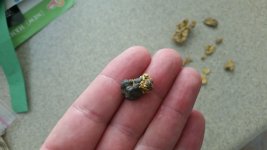Old Bookaroo
Silver Member
- Dec 4, 2008
- 4,318
- 3,510
Peg Leg Smith in 1848
While reading the very interesting Dreams of El Dorado; A History of the American West, by H.W. Brands (2019) – a thoughtful gift from my brother-in-law – I came across a reference to the following brief account of Peg Leg Smith’s whereabouts in the winter of 1848.
The Oregon missionaries Marcus and Narcissa Whitman, and twelve others, had been massacred by Cayuse Indians. Over fifty women and children had been taken hostage by the murders as shields against retribution.
The “Merry Mountain Man” Joesph L. Meek was delegated by the new provisional government to carry to Washington City news of the terrible event along with a petition for federal government protection.
In the face of the dangers of a winter journey across the continent – after his arrival, Sen. Thomas Hart Benton said “In the depth of winter they send to us a special messenger who makes his way across the Rocky Mountains at a time when almost every living thing perished in the snow, when the snow was at such a depth that nothing could penetrate to the bottom of it” – there were also hostile tribes with which to contend. At about the time described, Meek and his little band had traveled for two days without a rest to stay ahead of Bannocks demanding tribute, and then continuing east had to detour to avoid Lakota seeking the same.
Meek encountered an old friend along the way.
1848. Taking only a blanket and their rifles, and leaving the animals to find their way back to Fort Hall, the little party pushed on. Meek was now on familiar ground, and the old mountain spirit which had once enabled him to endure hunger, cold, and fatigue without murmuring, possessed him now. It was not without a certain sense of enjoyment that he found himself reduced to the necessity of shooting a couple of polecats to furnish a supper for himself and party. How long the enjoyment of feeling want would have lasted is uncertain, but probably only long enough to whet the appetite for plenty.
To such a point had the appetites of all the party been whetted, when, after several days of scarcity and toil, followed by nights of emptiness and cold, Meek had the agreeable surprise of falling in with an old mountain comrade on the identical ground of many a former adventure, the head waters of Bear River. This man, whom Meek was delighted to meet, was Peg Leg Smith, one of the most famous of many well-known mountain men. He was engaged in herding cattle in the valley of Thomas’ Fork, where the tall grass was not quite buried under snow, and had with him a party of ten men.
Meek was as cordially received by his former comrade as the unbounded hospitality of mountain manners rendered it certain he would be. A fat cow was immediately sacrificed, which, though not buffalo meat, as in former times it would have been, was very good beef, and furnished a luxurious repast to the pole-cat eaters of the last several days. Smith’s camp did not lack the domestic element of women and children, any more than had the trapper’s camps in the flush times of the fur trade. Therefore, seeing that the meeting was most joyful, and full of reminiscences of former winter camps, Smith thought to celebrate by a grand entertainment. Accordingly, after a great deal of roast beef had been disposed of, a dance was called for, in which white men and Indian women joined with far more mirth and jollity than grace or ceremony. Thus passed some hours of the night, the bearer of dispatches seizing, in true mountain style, the passing moment’s pleasure, so long as it did not interfere with the punctilious discharge of his duty. And to the honor of our hero be it said, nothing was ever allowed to interfere with that.
Refreshed and provided with rations for a couple of days, the party started out again next morning…
The River of the West; Life and Adventure in the Rocky Mountains and Oregon; embracing events in the life-time of a Mountain-Man and Pioneer with the Early History of the North-Western Slope including An Account of the Fur Traders, the Indian Tribes, the Overland Immigration, the Oregon Missions, and the Tragic fate of Rev. Dr. Whitman and Family. Also, A Description of the Country, Its Conditions, Prospects, and Resources; Its Soil, Climate, and Scenery, Its Mountains, Rivers, Valleys, Deserts, and Plaints. Its Inland Waters, and Natural Wonders, by Mrs. Frances Fuller Victor (1870)
Good luck to all,
The Old Bookaroo





